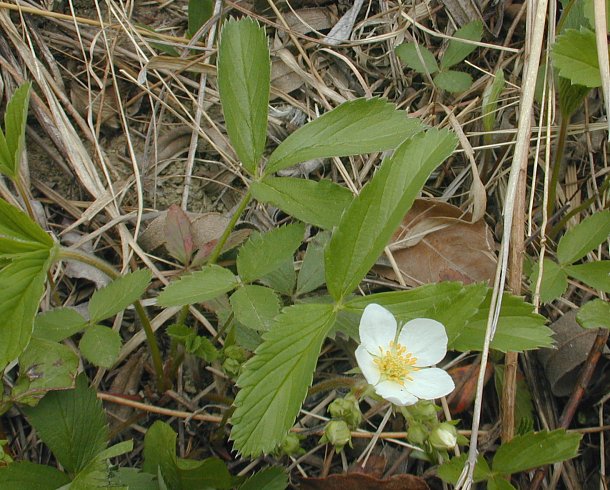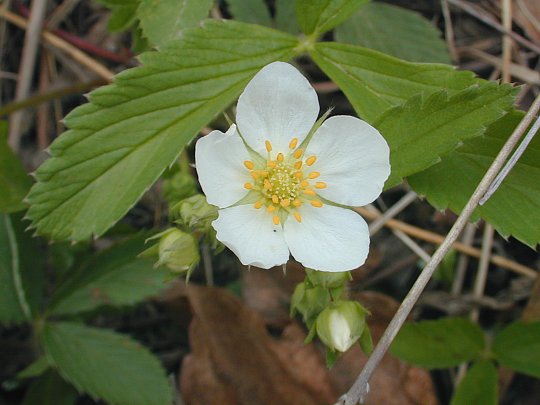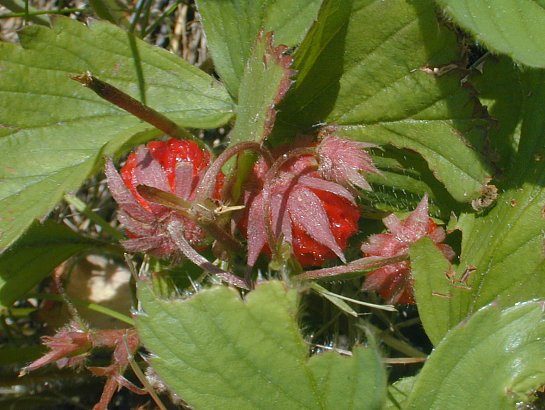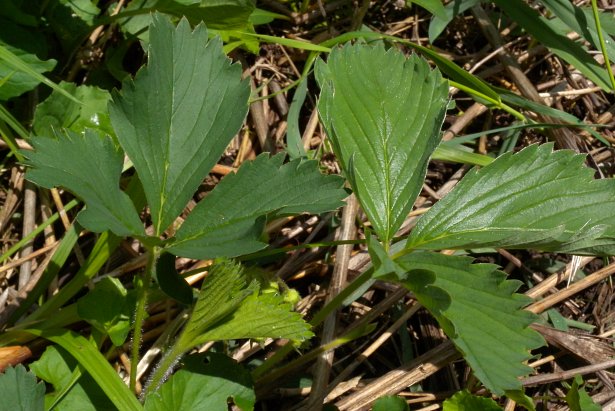Description: This herbaceous perennial plant is 4-7" tall, consisting of several basal leaves and one or more inflorescences. The basal leaves are trifoliate. The leaflets are up to 2½" long and 1½" across; they are obovate or oval in shape and coarsely toothed along their middle to outer margins. The tips of leaflets are rounded, while their bottoms are either wedge-shaped or rounded. The upper leaflet surface is medium to dark green and glabrous. The lower leaflet surface is variably hairy; fine hairs are most likely to occur along the bases of central veins, but they may occur elsewhere along the lower surface. Leaflet venation is pinnate and conspicuous. The petiolules (basal stalklets) of leaflets are light green, hairy, and very short (about 1 mm. in length). The petioles of basal leaves are up to 6" long; they are light green to light reddish green, terete, and hairy. One or more umbel-like clusters of flowers are produced from long peduncles up to 5" long. These peduncles are light green to light reddish green, terete, and hairy. Each umbel-like cluster has about 4-6 flowers on pedicels up to ¾" long. These pedicels are light green to light reddish green, terete, and hairy. At the base of these pedicels, there are several bracts up to ¼" long that are light green to dark red, lanceolate in shape, and hairy.

Individual flowers are about ½–¾" across when they are fully open; they can be pistillate, staminate, or perfect (staminate flowers are the least common). Each flower has 5 white petals, 5 green sepals, and 5 green sepal-like bracts. The petals are oval to orbicular in shape; they are longer than either the sepals or sepal-like bracts. The sepals are lanceolate in shape and hairy, while the sepal-like bracts are linear-lanceolate and hairy; both sepals and sepal-like bracts are joined together at the base of the flower. Each pistillate flower has a dome-shaped cluster of pistils at its center that is greenish yellow or pale yellow. Each staminate flower has 20-35 stamens with pale yellow filaments and yellow anthers. Each perfect flower has a dome-shaped cluster of pistils at its center and a ring of surrounding stamens. The blooming period occurs from late spring to early summer, lasting about 3-4 weeks. Afterwards, the flowers are replaced by fruits when growing conditions are favorable, otherwise they abort. These fruits are up to ½" long and across; they are globoid or globoid-ovoid in shape, becoming bright red at maturity. Small seeds are scattered across the surface of these fruits in sunken pits; the persistent sepals and sepal-like bracts are appressed to the upper surface of these fruits. The fleshy interior of these fruits has a sweet-tart flavor; they are edible. The root system consists of a shallow crown with fibrous roots. After the production of flowers and fruits, hairy above-ground stolons up to 2' long may develop from the crown. When the tips of these stolons touch the ground, they often form plantlets that take root. In this manner, clonal colonies of plants often develop.

Cultivation:
The preference is full or partial sun, moist to dry-mesic
conditions, and fertile soil containing loam or clay-loam. Wild
Strawberry is a cool-season plant that grows actively during the spring
and fall, but it often becomes dormant after setting fruit during the
hot summer months. This plant is easy to cultivate, and it will spread
to form a loose ground cover in open areas. The foliage is more
resistant to foliar disease than most cultivated strawberries. While
flowers are produced reliably every spring where there is adequate
sunlight, the fruits may or may not develop, depending on the weather
and environmental conditions. Watering plants during dry spells in late
spring and early summer probably encourages fruits to develop. These
fruits are much smaller in size than those of cultivated strawberries.
Range & Habitat:
The native Wild Strawberry is common in most areas of
Illinois, although in parts of NW and southern Illinois it is
occasional or absent (see Distribution
Map).
Habitats include black soil prairies, hill prairies, bluegrass
meadows, small meadows in wooded areas, open woodlands, woodland
borders, savannas, limestone glades, roadsides, and areas along
railroads. Wild Strawberry is able to tolerate competition from taller
plants because it develops early in the spring, and it is able to
tolerate some shade later in the year. This plant occurs in both
degraded and high quality habitats, often not far from wooded areas.

Faunal Associations: The ecological value of Wild Strawberry to various insects, birds, and animals is high. The nectar and pollen of the flowers attract little carpenter bees (Ceratina spp.), cuckoo bees (Nomada spp.), mason bees (Osmia spp.), Halictid bees (including green metallic bees), Halictid cuckoo bees (Sphecodes spp.), Andrenid bees, Syrphid flies, thick-headed flies (Conopidae), Tachinid flies, bottle flies (Lucilia spp.), flesh flies (Sarcophagidae), small butterflies, and skippers (see Robertson, 1929, & others). These floral visitors are beneficial because they cross-pollinate the flowers. Other insects feed destructively on the foliage and other parts of Wild Strawberry. Caterpillars of the Grizzled Skipper (Pyrgus centaurae wyandot) feed on this plant. Other insect feeders include larvae of such moths as the Strawberry Crown Borer (Synanthedon bibionipennis), Strawberry Leafroller Moth (Ancylis comptana fragariae), and Wild Strawberry Seed Borer (Grapholita angleseana). The Moth Table has a more complete list of moth species that feed on this plant.

Other insect feeders include the Strawberry Flea Beetle (Altica ignita) and other leaf beetles (Chrysomelidae), the Strawberry Sap Beetle (Stelidota gemmata), the Strawberry Root Weevil (Otiorhynchus ovatus) and other weevils (Curculionidae), larvae of the Strawberry Reniform Gall Midge (Cecidomyia reniformis), larvae of the Strawberry Cylindrical Gall Wasp (Diastrophus fragariae), larvae of the Curled Rose Sawfly (Allantus cinctus) and other sawflies, the Strawberry Aphid (Chaetosiphon fragaefolii) and other aphids, and flower thrips. The Insect Table has a more complete list of insect species that feed on this plant. Various vertebrate animals eat the fruits and foliage of Wild Strawberry. Some upland gamebirds and songbirds eat the fruits, including the Ring-necked Pheasant, Brown Thrasher, Eastern Towhee, Veery, and American Robin. Some mammals, including the American Black Bear, Opossum, Franklin Ground Squirrel, Eastern Chipmunk, and White-footed Mouse, also eat the fruits, as do the Eastern Box Turtle, Ornate Box Turtle, and Wood Turtle. By eating the fruits, these animals spread the seeds to new locations. The foliage of Wild Strawberry is a source of food for the Ruffed Grouse and Cottontail Rabbit; it is also browsed by horses, cattle, sheep, and goats. The Wildlife Table has a more complete list of vertebrate animals that feed on this plant.

Photographic
Location:
The photographs were taken along a roadside near Urbana,
Illinois; at Dave Monk's postage stamp prairie in Champaign,
Illinois; and at the wildflower garden of the webmaster in Urbana,
Illinois.
Comments:
This is one of the parent plants for the cultivated strawberry (Fragaria × ananassa).
The other parent plant of the cultivated strawberry is the Coastal
Strawberry (Fragaria
chiloensis).
This latter species is found along the Pacific Coast in both North and
South America. The cultivated strawberry inherited the superior flavor
of the Wild Strawberry (Fragaria
virginiana)
and the larger fruit size of the Coastal Strawberry. The Wild
Strawberry produces attractive white flowers during the spring and
small red fruits during the early summer. It is similar in appearance
to another native species, the Hillside Strawberry (Fragaria vesca americana).
The fruits of Hillside Strawberry have sepals and sepal-like bracts
that are spreading to reflexed, rather than appressed. The fruits of
Hillside Strawberry also have seeds scattered on top of their surfaces,
rather than enclosed in shallow pits. This strawberry species is found
in northern Illinois, where it is uncommon. It is closely related to
the Alpine Strawberry (Fragaria
vesca vesca), which is found in Europe.